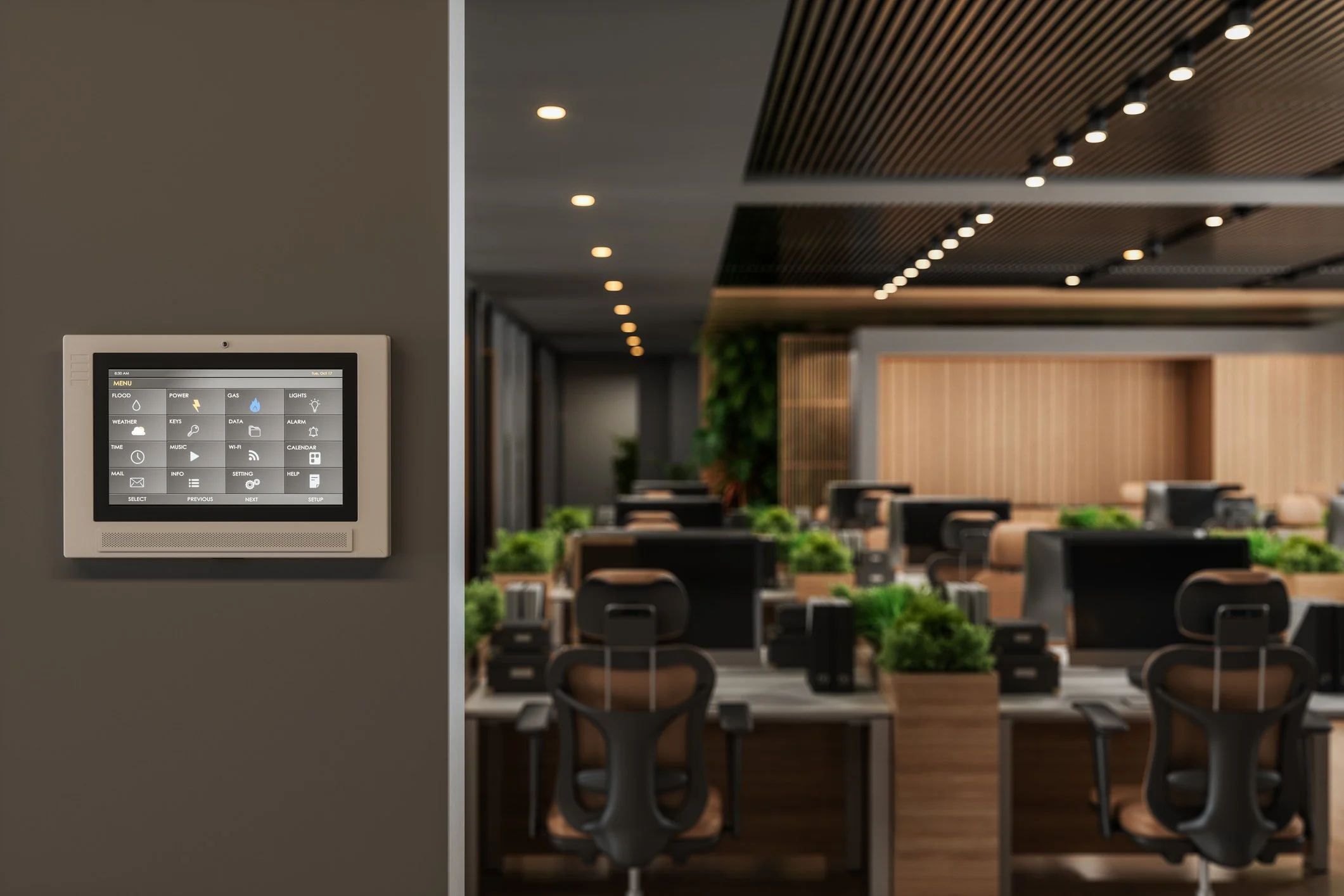Ideas for Creating Modern Office Space Designs
Create a modern office space by combining open floor plans with flexible furniture that adapts to changing needs. You'll want to integrate smart technology solutions like wireless connectivity and IoT devices, while incorporating ergonomic furniture and wellness features. Use strategic lighting design with adjustable LEDs and maximize natural light to boost productivity. Add sustainable materials like reclaimed wood and living walls for an eco-friendly touch. The following details will help transform your workspace into a cutting-edge environment.
Article Main Points
Implement flexible open floor plans with modular furniture and designated collaboration zones to promote teamwork while maintaining professional workflow.
Integrate smart technology solutions including wireless connectivity, IoT devices, and automated lighting controls for enhanced workplace efficiency.
Install ergonomic furniture and wellness features like adjustable chairs, air purification systems, and relaxation areas to prioritize employee comfort.
Use strategic color schemes and lighting design combining natural light, LED systems, and task lighting to boost productivity and mood.
Incorporate sustainable materials such as reclaimed wood, recycled glass, and living walls to create eco-friendly spaces that reduce environmental impact.
Open Floor Plan Concepts and Configurations
When you're planning a modern office layout, open floor plans remain one of today's most popular and versatile design choices. You'll find that these spacious environments encourage collaboration while maximizing your available square footage.
To create effective Open Zones, consider these key elements:
Movable furniture and modular workstations
Designated collaboration areas with flexible seating
Sound-absorbing materials and strategic barriers
Natural light integration through minimal wall placement
Your Flexible Layouts should incorporate:
Activity-based working areas
Quiet zones for focused work
Social hubs for casual interaction
Tech-enabled meeting spaces
Don't forget to balance openness with privacy - you can achieve this by mixing open areas with:
Glass-walled meeting rooms
Mobile privacy screens
Strategically placed plants and dividers
Acoustic pods for private calls
Remember: The key to successful open floor plans lies in creating distinct zones while maintaining visual connectivity throughout the space.
Collaborative Workspaces and Meeting Areas
Modern offices consistently require well-designed collaborative workspaces and meeting areas to foster teamwork and innovation. You'll want to create spaces that encourage natural interaction while maintaining functionality.
Consider these key elements:
Flexible layouts that adapt to different needs:
Moveable furniture and partitions
Multi-purpose zones that transform from meeting spaces to breakout areas
Mobile whiteboards and presentation tools
Shared amenities that promote engagement:
Coffee bars and casual seating nooks
Technology hubs with video conferencing capabilities
Informal gathering spots with comfortable seating
You'll find that successful collaborative spaces balance privacy with openness. Include sound-dampening elements to minimize noise disruption, and don't forget to incorporate plenty of power outlets for devices.
When you're planning these areas, remember that the best collaborative spaces feel inviting but maintain a professional atmosphere. Consider using glass walls to maintain visual connection while controlling acoustics.
Technology Integration and Smart Office Solutions
Modern office spaces demand seamless technology integration, and you'll want to start with enterprise-grade wireless connectivity that supports your entire workforce's devices and IoT systems. Smart lighting controls can automatically adjust based on natural light and occupancy patterns, helping you create the perfect environment while reducing energy costs.
Your meeting spaces should feature integrated solutions like wireless presentation systems, smart boards, and video conferencing equipment that let you connect with teams across the globe at the touch of a button.
Wireless Connectivity Solutions
Seamless wireless connectivity forms the backbone of any sophisticated office environment. To create a truly connected workspace, you'll need to implement robust wireless networks that support your team's productivity and mobility needs.
Key Implementation Steps:
Install enterprise-grade routers with mesh networking capabilities
Maximize network coverage through strategic access point placement
Set up separate networks for guests and internal teams
Implement network optimization tools for bandwidth management
Your wireless infrastructure should accommodate:
High-speed internet access throughout the space
Multiple device connections per employee
Cloud service accessibility
Video conferencing requirements
IoT device integration
Don't forget to future-proof your setup by choosing scalable solutions that can grow with your business. Regular network performance monitoring will help maintain ideal connectivity speeds and identify potential bottlenecks before they impact productivity.
Smart Lighting Control Systems
Three core components of a productive office environment—comfort, efficiency, and sustainability—come together in smart lighting control systems.
You'll transform your workspace with lighting automation that adapts to your team's needs throughout the day.
Key Smart Lighting Features:
Motion sensors that automatically adjust brightness based on occupancy
Daylight harvesting that maximizes natural light usage
Programmable schedules for different zones and times
Mobile app control for individual workspace customization
You're not just saving energy—you're creating an environment that enhances focus and productivity.
Install sensors in conference rooms to automatically dim lights during presentations, or set up warm-to-cool light shifts that match your team's natural circadian rhythms.
Modern lighting control systems even integrate with your building management system, providing valuable data on space utilization and energy consumption.
Integrated Meeting Room Technology
Modern meeting rooms demand sophisticated technology integration that transforms basic conference spaces into dynamic collaboration hubs. You'll want to incorporate essential components like audio conferencing systems and virtual screens to create seamless communication between in-person and remote participants.
Feature: Smart displays, audio systems, video solutions
Benefit: Interactive presentations, crystal-clear sound, remote collaboration
Implementation: Wall-mounted touchscreens, ceiling microphone arrays, 4K cameras with AI tracking
When planning your meeting room tech setup, consider these key elements:
Wireless connectivity for instant screen sharing
Integrated controls for one-touch operation
Smart scheduling displays outside rooms
Virtual whiteboarding capabilities for remote brainstorming
Remember to future-proof your installation by choosing scalable solutions that can adapt to emerging technologies and changing workplace needs.
Ergonomic Furniture and Wellness Features
Thoughtful workplace design starts with prioritizing employee health and comfort through ergonomic furniture and wellness-focused features. When you're planning your office space, implementing targeted ergonomics should be at the top of your list. Start with adjustable chairs that support proper posture and standing desks that let employees alternate between sitting and standing throughout the day.
Don't forget these essential wellness amenities:
Natural light optimization with smart window placement
Air purification systems for better breathing
Sound-absorbing materials to reduce noise stress
Dedicated relaxation zones for mental breaks
Consider investing in:
Monitor arms with adjustable heights
Ergonomic keyboards and mice
Anti-fatigue floor mats
Proper task lighting
You'll want to position workstations to encourage movement and stretching. Remember, a comfortable employee is a productive employee. The key is creating a space that supports both physical and mental well-being while maintaining professional efficiency.
Color Psychology and Lighting Design
Building on the foundation of ergonomic comfort, the strategic use of color and lighting can transform your office space into a powerhouse of productivity and mood enhancement. Your color scheme choices can dramatically influence employee behavior, while proper mood lighting helps maintain focus throughout the day.
Install adjustable LED lighting systems that mimic natural daylight, helping regulate your team's circadian rhythms
Choose cool blues and greens in focus areas to promote concentration and calm
Add energizing yellows and oranges in collaborative spaces to spark creativity
Incorporate natural materials and earth tones to reduce stress and eye strain
Layer your lighting with task lights, ambient fixtures, and natural light sources
You'll want to balance bright, energizing areas with calmer zones where employees can recharge. Remember: different colors affect people differently, so it's smart to create varied spaces that suit different work styles and preferences. Consider conducting a test run with temporary color applications before making permanent changes.
Sustainable Materials and Eco-Friendly Elements
If you're looking to create an eco-conscious workspace, start by incorporating recycled materials like reclaimed wood furniture, salvaged metal fixtures, and repurposed glass partitions into your office design. You'll find that living walls, which are vertical gardens installed indoors, can transform your space while naturally filtering air and reducing energy costs.
These sustainable choices not only minimize environmental impact but also signal your company's commitment to green practices, often becoming mesmerizing focal points that inspire both employees and visitors.
Recycled Construction Components
Incorporating recycled materials into modern office design has become a cornerstone of sustainable architecture. You'll find that the reuse of plastics and repurposed materials not only reduces environmental impact but also adds character to your workspace.
When you're planning your office renovation, consider these innovative recycling options that'll make your space both eco-friendly and stylish.
Salvaged wood beams and panels from demolished buildings can create stunning accent walls
Recycled glass partitions, crafted from post-consumer materials, offer modern transparency
Reclaimed metal fixtures and hardware add industrial charm while reducing waste
Repurposed plastic furniture made from ocean waste brings sustainability full circle
Construction blocks manufactured from recycled concrete showcase circular economy principles
Living Walls Implementation
Living walls represent a dynamic fusion of nature and architecture that's transforming modern office spaces into vibrant, sustainable environments. You'll need to think about proper maintenance planning and structural impact before implementing this green solution.
Key Implementation Steps:
Assess your wall's load-bearing capacity
Select appropriate plant species for indoor conditions
Install proper irrigation and drainage systems
Plan for regular maintenance access
When you're designing your living wall, think about the lighting conditions and choose plants that'll thrive in your specific environment. You can create stunning visual effects by mixing different textures and colors of vegetation. Remember that structural impact isn't just about weight - you'll need to account for moisture protection and ventilation systems too.
Pro tip: Start with a small pilot area to test maintenance requirements before scaling up.
Frequently Asked Questions
How Much Should I Budget per Square Foot for a Modern Office Renovation?
You'll need to budget $150-300 per square foot for modern office renovation costs, depending on your location and finish quality. High-end metropolitan areas and premium materials can push costs toward the upper range.
What Insurance Considerations Are Needed When Redesigning an Office Space?
You'll need extensive liability coverage to protect against accidents during renovation and property protection for your new design elements. Don't forget to update your policy limits for added features and equipment.
How Long Does a Complete Office Redesign Typically Take to Implement?
You'll need 3-6 months for a complete office redesign. The project timeline varies based on scope, but typically includes design phases like planning, demolition, construction, furnishing, and final installations for your workspace transformation.
What Permits Are Required Before Starting an Office Space Renovation?
You'll need to secure zoning compliance approval and renovation permits from your local building department. Don't forget to check for specific requirements like electrical, plumbing, and structural permits for your workspace transformation.
Can Employees Continue Working During an Office Redesign Project?
Clients can keep their team productive during renovations by setting up temporary workstations and implementing phased scheduling. This approach lets them maintain operations while transforming the space, minimizing disruption to daily workflows.


